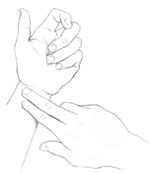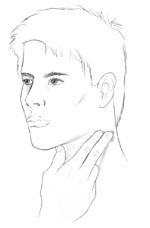How to Take a Pulse
How to Take a Pulse
There are several different ways to take a pulse. If you can't feel a pulse at one location, you will need to try another area on the individual's body, as detailed in the following steps.
First Aids
The pulse is the movement of blood through the arteries. When the heart beats, the walls of the arteries swell with blood. Between beats, as the blood moves along, the walls shrink back to normal size. The rhythmic swelling and shrinking is what you feel when you take a person's pulse. Take the pulse at the wrist.
Ouch!
Never use your thumb to take a pulse. It has a pulse of its own, and what you feel while trying to locate a pulse may be your own beating heart and not the injured person's.

- Place your second (index) and third (middle) finger on the inside of the injured person's wrist. Your fingers should be right below the wrist crease and near the thumb. Press down. If you find the pulse, go on to step 4; if you don't, proceed to the next step.
- If you can't feel a pulse at the wrist, try the carotid artery at the neck. This is located below the ear, on the side of the neck directly below the jaw. You should feel the artery as you exert pressure on the neck. (This is the best place to take a pulse if you have to give mouth-to-mouth resuscitation.) If you find the pulse, go to step 4; if you don't, proceed with step 3.
- If you still can't feel a pulse, try using the same two fingers on either side of the Adam's apple at the throat, the femoral pulse at the groin, or in between the muscles on the inner side of the upper arm.
- As soon as you feel a pulse, count the pulse beats for fifteen seconds (you'll need a watch), exerting pressure with your two fingers the whole time.
- Multiply the number you get by four. This gives you the individual's heartbeats per minute, or pulse rate.

carotid artery.
A normal pulse ranges from 60 to 90 beats per minute. Babies can have pulse rates up to 120 beats per minute; young children's pulses range from 80 to 160.
A rapid pulse can be a sign of shock or severe strain on the heart such as an asthma attack or electrocution. If the beats are very faint or weak, an injured person might be in shock, his blood flow might be restricted, he might be in a hypothermic condition (from the cold), or he might be suffering from several other conditions. The main thing to be aware of when it comes to a faint heartbeat is to keep an ear out and keep an eye on the person's breathing. If the heartbeat is slow and is combined with ragged, almost nonexistent breathing, an emergency situation is definitely in progress. You might have to perform CPR (if you are trained and certified) or mouth-to-mouth resuscitation until help arrives.
First Things First
If the pulse you find is very erratic, don't rely on math. Take a full 60 seconds to count the beats.
Practice taking a pulse on yourself or a family member so you'll be familiar with the process in case of an emergency.
Listening to the Heartbeat
Listening to an injured person's heartbeat is just as important as taking his or her pulse. Obviously, a heartbeat means the person is alive—even if the pulse is so weak that you can't feel it at any location. Here's how to listen to a heartbeat.
- For men: Put your ear below the breastbone, slightly to the left of the left nipple.
For women: Put your ear right below the left breast.
For children: Put your ear slightly to the left of the left nipple.
- Count the heartbeats you hear for one full minute.
A normal adult heart beats between 60 and 90 beats per minute. Children and babies can have ranges higher. When a heartbeat is too fast, it can mean the victim is suffering from agitation or panic, shock, or fever. Treat each of those conditions as needed.